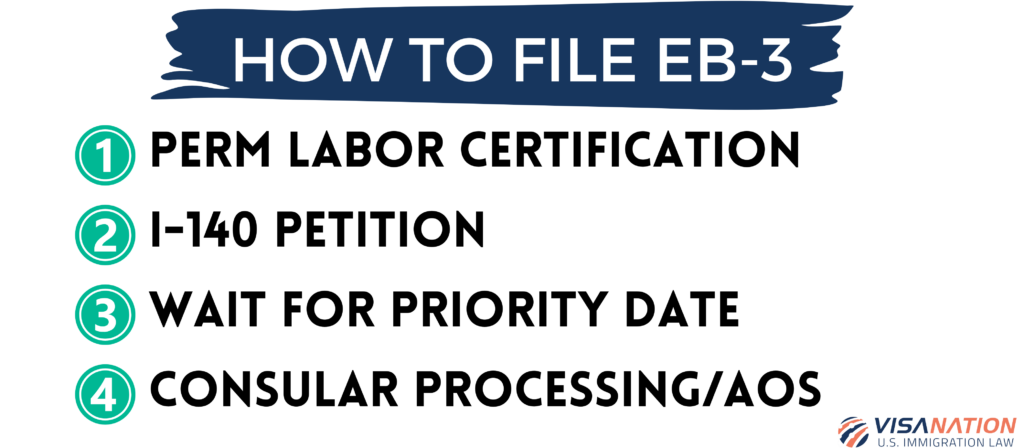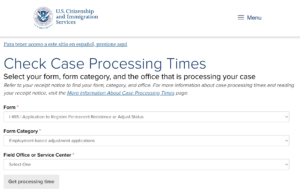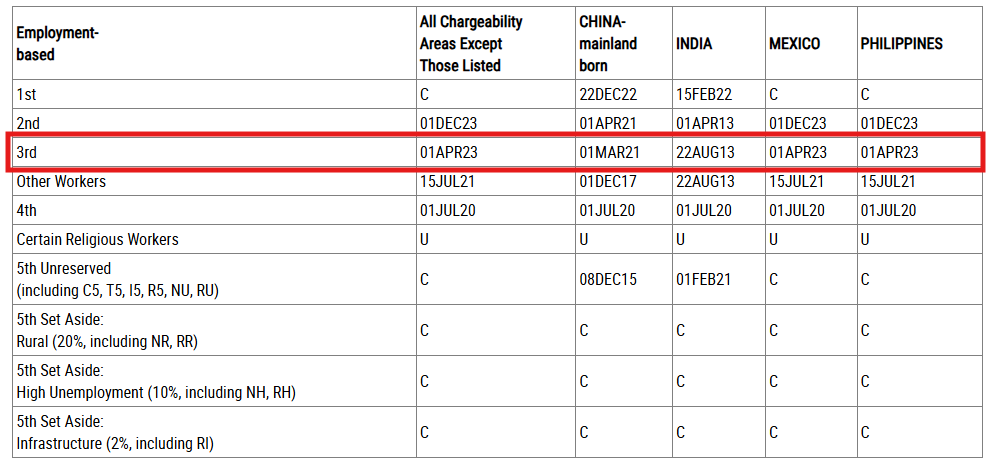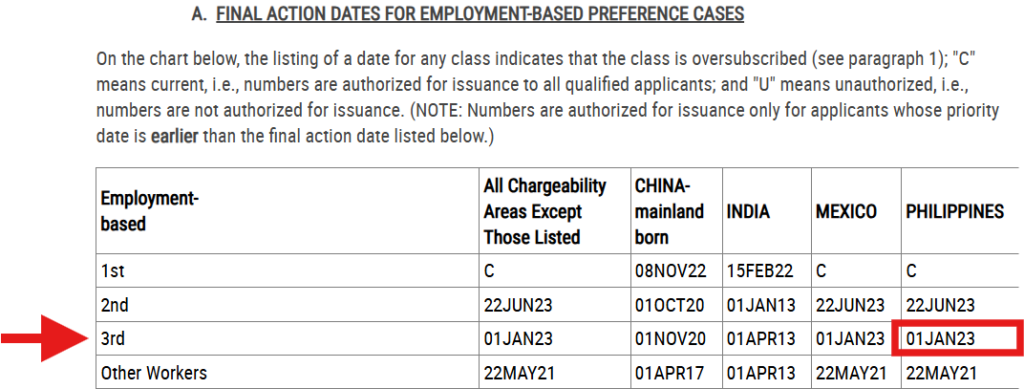One of the most common employment-based green cards is the EB-3 green card due to its relatively low eligibility requirements. However, this also makes it very popular, which impacts the timeline to obtain one. Read this guide to learn all about EB-3 green card processing times and a timeline for the entire process.
EB-3 Processing Time
The EB-3 green card processing time is approximately two to five years; however, an applicant from China or India may take 5 to 10+ years. To understand the timeline, it’s key to understand each step of the EB-3 green card process:
- PERM Labor Certification
- I-140
- Waiting for Priority Date to Become Current
- Adjustment of Status or Consular Processing

Step One: PERM Labor Certification (2 Years)
The purpose of PERM labor certification is to ensure that hiring a foreign worker will not adversely affect the wages and working conditions of U.S. workers or displace any who are able, willing, qualified, and available for the job. It involves:
- Prevailing Wage Determination: According to the Department of Labor, prevailing wage determinations take approximately five months.
- Recruitment: After the prevailing wage determination, the employer must undergo mandatory recruitment to test the U.S. labor market. This process takes 2 to 3 months.
- Application for Permanent Employment Certification (Form ETA-9089): After the Form ETA-9089 application is filed, the Department of Labor takes ~16 months to process the document. If your employer is audited, it could extend the processing time further.
Step Two: I-140 Processing Time (~8 Months)
- According to USCIS data, the I-140 petition takes ~8 months to process
- If your employer uses premium processing, the I-140 will be processed within 15 business days.
Step Three: Priority Date and Visa Bulletin (2+ years)
Before you can file for a green card, you must wait for your priority date to become current in the visa bulletin. The Priority Date is the date the PERM Application (Form ETA-9089) was filed by your employer with the Department of Labor.
It serves as your place in the line for an immigrant visa. The wait time for EB-3 depends on your country of origin due to visa caps placed on each country.
- For most countries, there is a wait time of approximately 2 years before your priority date is current.
- For India and China, wait times are significantly longer.
- China has wait times of over four years
- India has wait times of over twelve years.
Importantly, while your Application for Permanent Employment Certification (Form ETA-9089) is processing, the final action dates in the visa bulletin will continually progress.
Step Four: Adjusting Status or Consular processing (3-12 Months)
After your priority date is current, you can move on to the next step. Those in the U.S. on a valid non-immigrant visa will adjust their status through adjustment of status using Form I-485. This typically takes 6-12 months.
Unfortunately, there is no way to expedite this. To get the most accurate estimate of your I-485 processing time, use the USCIS processing time tool. Enter your specific form into the fields and your field office/service center processing your case, then click “Get Processing Time.” 
For those living abroad, you will undergo consular processing. This process typically takes 3 to 6 months, depending on the appointment availability at the embassy. Consular process involves:
- Paying processing fees
- Submitting the DS-260 form
- Uploading documents to an online portal
- NVC document review
- Medical examination with a panel physician authorized by the U.S. Department of State
- An interview with a U.S. consulate or embassy in your home country.
Importantly, while the EB-3 green card process has different steps, in the timeline they don’t always happen one after the other. Some steps happen at the same time.
For example, while the government is reviewing your paperwork (like the I-140 form or ETA-9089 form), your spot in the visa line is constantly moving forward. So even though you’re waiting for an approval of multiple forms, you’re not losing your place in line.
EB-3 Wait Time by Country
The final action dates published in the Visa Bulletin provide an estimated wait time by country for the EB-3 Green Card.
- India: The estimated wait time is approximately 12 years and 2 months.
- China (mainland born): The estimated wait time is approximately 4 years and 7 months.
- Mexico, Philippines, and All Other Countries: The estimated wait time is approximately 2 years and 6 months.
Discuss with your attorney about the most up-to-date information regarding the EB-3 wait time for your country. In some cases, porting may be a better option for you.

Can Premium Processing Speed Up EB-3 Processing Time?
USCIS offers an optional service to expedite the process of all visa petitions that use the I-129 or I-140 forms. By paying an additional fee of $2,805, you can shorten the processing time of your EB-3 petition to 15 business days. However, this does not expedite any other step in the EB-3 process.
It is also important to note that, if your priority date will not be current for some time, premium processing may not help, as you cannot adjust your status or undergo consular processing until your priority date is current, even if your I-140 is approved.
Speak with your immigration attorney to learn if premium processing is right for your case.
How do EB-3 Priority Dates Work?
Your EB-3 priority date is the day that the Form ETA-9089 was filed with the DOL. You will need to reference this date when checking the monthly visa bulletin released by the Department of State.
Each year, there is a limit on how many immigrant visas are granted in each category. When the limit is exceeded, a backlog is created that can cause people from certain countries to wait from a few months to several years.
The visa bulletin provides the final action dates for the EB-3 Visa according to the applicant’s country of origin, so keep an eye on the date in your category. Here is an example:
Diana is a nurse from the Philippines who wants to work as a nurse in the U.S. Her priority date is August 1st, 2022. She checks the most recent visa Bulliten, finding the section associated with the final action dates for employment-based preference cases.
Based on the final action date of January 1st, 2023, she will likely have to wait at least 5 months before she can apply for a change of status and obtain her green card. However, based on demand for the EB-3, the Visa Bulliten occasionally does not progress.
Herein lies the problem with the EB-3 processing time for citizens of select countries (i.e., China and India). The final action dates can be backlogged for five to ten+ years. This EB-3 Visa Bulletin queue must be taken into account when considering the total EB-3 Processing times.
However, this is not always the case. Sometimes, the dates for many of the chargeability areas become or remain current, which can reduce the waiting times for the EB-3 green card.
Tip: Always be sure to check the most recent visa bulletin and consult with your immigration attorney to see how long you will have to wait before you can adjust your status or use consular processing.
To get a broader picture of how green cards are allocated, of the total 140,000 slots available for foreign workers, 28.6% (about 40,000) are designated for the EB-3 category. Additionally, no more than 7% of these EB-3 visas can go to foreign workers of any one particular country. For that reason, there is often a backlog due to the higher demand than the available visas.
Frequently asked questions
What is the eb3 green card processing time for indian?
EB-3 Applicants from India face long processing times, with a minimum wait of 12 years according to the Department of State Visa Bulletin.
How long is the EB-3 PERM process
The EB-3 PERM application takes around 16 months to process.
Can EB-3 visa holders bring dependents?
Yes, EB-3 Visa holders can bring their families. Just like every other employment-based green card, if your EB-3 visa is approved, your immediate relatives (spouse and unmarried children under the age of 21) can join you in the U.S.
Can We Change from EB3 to EB2 after I-140 Approval?
Because the wait times can be so long for certain priority dates, there are situations where an applicant gains the education or requirements necessary to upgrade his or her green card. If you originally applied for an EB-3 and gained your Master’s degree while you waited, you could be eligible to reapply for an EB-2, which is sometimes referred to as ‘porting’ (although, it isn’t so much porting as it is starting over from square one for the I-140 process). You may also be able to retain your original priority date.
However, you would first need to get a different job that clearly requires your new education. This can be achieved either through your current employer or with a new one. Here is an example:
Purna is an electrical engineer from India with his bachelor’s degree in that field. He applies for the EB-3, but his priority date will not be current for almost ten years. So, he continues his education and gets his Master’s degree. To re-apply for an EB-2 under this new qualification, Purna needs to find a job either through a promotion or with a different employer that makes use of his new Master’s degree.
If you are eligible to port your green card and you have found a suitable job, the employer that is sponsoring you for the new green card will need to obtain a new PERM Labor Certification for you before filing another I-140. Because this is a delicate process, always work closely with your immigration attorney in cases such as these.
Recommended read: EB-3 to EB-2 Porting












